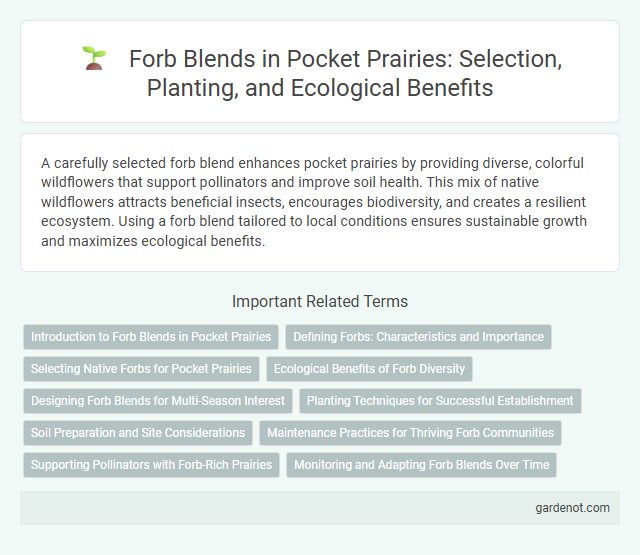A carefully selected forb blend enhances pocket prairies by providing diverse, colorful wildflowers that support pollinators and improve soil health. This mix of native wildflowers attracts beneficial insects, encourages biodiversity, and creates a resilient ecosystem. Using a forb blend tailored to local conditions ensures sustainable growth and maximizes ecological benefits.
Introduction to Forb Blends in Pocket Prairies
Forb blends in pocket prairies consist of diverse herbaceous flowering plants selected to enhance biodiversity, soil health, and pollinator support. These blends typically include species like coneflowers, black-eyed Susans, and milkweed, which contribute to a resilient and vibrant ecosystem. Incorporating forb blends promotes habitat creation, improves nutrient cycling, and attracts beneficial insects essential for ecological balance in small-scale prairie restorations.
Defining Forbs: Characteristics and Importance
Forbs are herbaceous flowering plants that are distinct from grasses, sedges, and woody plants, often characterized by broad leaves and vibrant blooms. These plants play a crucial role in pocket prairies by enhancing biodiversity, supporting pollinators like bees and butterflies, and improving soil health through deep root systems. Incorporating a diverse forb blend increases habitat complexity and promotes ecological resilience in restored prairie ecosystems.
Selecting Native Forbs for Pocket Prairies
Selecting native forbs for pocket prairies enhances biodiversity by supporting local pollinators and wildlife. Prioritize species such as Echinacea purpurea, Asclepias tuberosa, and Solidago canadensis for their adaptability to regional soils and climates. Incorporating a diverse forb blend ensures seasonal blooms, improves soil health, and strengthens ecosystem resilience.
Ecological Benefits of Forb Diversity
Forb blend enhances pocket prairie ecosystems by increasing plant species richness, which supports a diverse range of pollinators and native wildlife. Diverse forbs improve soil health through enhanced nutrient cycling and erosion control, contributing to greater ecosystem resilience. This biodiversity also creates habitat complexity, promoting balanced food webs and ecosystem stability in restoration projects.
Designing Forb Blends for Multi-Season Interest
Designing forb blends for pocket prairies enhances multi-season interest by selecting diverse species with staggered bloom times, ensuring continuous visual appeal from spring through fall. Incorporating native forbs like Echinacea purpurea, Rudbeckia hirta, and Asclepias tuberosa supports pollinators while providing vibrant color shifts across seasons. Strategic planting of early, mid, and late-blooming forbs creates resilient, dynamic habitats promoting biodiversity throughout the year.
Planting Techniques for Successful Establishment
Selecting a diverse forb blend enhances biodiversity and soil health in pocket prairie plantings. Optimal planting techniques include sowing seeds at appropriate depths and ensuring good seed-to-soil contact to maximize germination rates. Applying light irrigation after planting supports seedling establishment and reduces competition from invasive species.
Soil Preparation and Site Considerations
Forb blend applications require well-drained soil with proper aeration to support diverse native plant growth in pocket prairies. Site considerations include assessing sunlight exposure, existing vegetation, and soil pH to ensure optimal forb establishment and longevity. Preparing the site through weed removal, loosening compacted soil, and incorporating organic matter enhances forb root development and nutrient uptake.
Maintenance Practices for Thriving Forb Communities
Effective maintenance practices for thriving forb communities in pocket prairies include periodic mowing or controlled burning to reduce invasive grasses and stimulate forb growth. Regular monitoring for invasive species and targeted removal ensures native forbs receive adequate sunlight and nutrients. Soil health improvement through organic mulch application supports diverse forb root systems and promotes long-term ecosystem resilience.
Supporting Pollinators with Forb-Rich Prairies
Forb blends in pocket prairies create diverse habitats rich in nectar and pollen, essential for supporting native pollinators such as bees, butterflies, and hummingbirds. Species like coneflowers, black-eyed susans, and milkweed enhance floral diversity and bloom continuity, which sustains pollinator populations throughout the growing season. Establishing forb-rich prairies improves ecosystem resilience and promotes biodiversity critical for pollinator health and reproduction.
Monitoring and Adapting Forb Blends Over Time
Monitoring forb blends in pocket prairies involves regular assessment of species composition, growth rates, and flowering patterns to ensure ecological balance and pollinator support. Adapting forb blends requires analyzing data on soil conditions, climate variations, and invasive species impact, followed by timely reseeding or selective removal to maintain biodiversity. Consistent monitoring enables early detection of shifts in plant dynamics, facilitating adaptive management that sustains the resilience and functionality of pocket prairie ecosystems.
Forb blend Infographic

 gardenot.com
gardenot.com